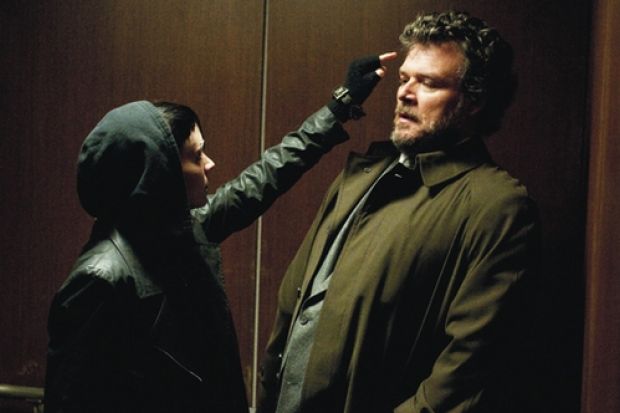The Girl with the Dragon Tattoo
Directed by David Fincher
Starring Daniel Craig, Rooney Mara, Stellan Skarsgard and Robin Wright
Released in the UK on 26 December
David Fincher's movie translates Stieg Larsson's novel (already adapted into a film by Niels Arden Oplev in 2009) into English, strips out some of its family psychodrama, retains its Swedish setting, and shoots it in black and white. That is, the film is full colour, but the snow-blind, wind-scoured, bleached-out landscape often renders its figures as dark marks, wrapped tightly in winter coats against blank backgrounds. It's the serial killer aesthetic of documents, files and murder portraits - Jonathan Demme's Silence of the Lambs, Fincher's own Zodiac and Se7en - in the frigid climate and over-exposed light of Christopher Nolan's Insomnia. Trent Reznor's soundtrack provides an eerie undercurrent of wind through pipes, glockenspiel, tautly plucked strings, clock chimes and an urgent, chugging guitar that pulses beneath the drama.
Daniel Craig plays journalist Mikael Blomkvist as heavy, grizzled and crumpled; it's a mature, humble performance from the Bond star, allowing co-star Rooney Mara to steal the film as Lisbeth Salander. Mara is compelling from her first shot, striding fast and looking ahead, all angular, jerky nods and head-tilts like a crow. Black leather creaks as she moves; her hair sticks up in brittle spikes while her black-lipsticked mouth pecks at a cigarette. She inhabits the city's subcultures like a wary goblin, her face blue-lit as she bends over laptops, her fingertips rattling out the clacking rhythms of computer hacking. This is not an imitation of Noomi Rapace's 2009 performance, but a close adaptation, retaining the quick Swedish greeting of "hej hej" and the brusque thanks of "tak".
The title, of course, foregrounds Lisbeth as the focus: but the original Swedish title, Men Who Hate Women, is more fitting. The production notes justify the name change as "an ode to Lisbeth Salander's lure", which only highlights the problem. Lisbeth Salander is 24 years old, with a hard life behind her and a hard shell around her; she's no girl. The dragon tattoo is visible only when she's nude, which constructs the film, inevitably but subtly, as a build-up to its reveal. That Lisbeth is first shown naked during a sexual assault, and secondly when she's showering off the blood, complicates the title's eroticisation of her body.
"We're looking for a serial murderer," muses Mikael, as they scroll through a catalogue of crime-scene photos. "Am I missing anything?" Some of the bodies have been decapitated, some have been burned. All are naked. All were once women. Among the violations, one word, "raped", recurs through Lisbeth's descriptions of each crime. Mikael is missing something, and so is the title: the fact that this story is not about a girl and her body, but a catalogue of sexual violence against women that began in the 1940s and was passed on from father to son, into the present day. Fincher's film cuts a key scene where Lisbeth is abused and called "bitch" by random men in a subway; by adapting the incident into a simpler property theft, he lessens the impact of the original novel and earlier film. Like Nazism, those versions reminded us, a hatred of women is not confined to twisted individuals, but symptomatic of a broader culture, and it is manifested in the smallest street abuse as well as in the grossest multiple homicide.
Fincher styles Lisbeth as more of a one-off - she herself confesses "I am insane" - which narrows Larsson's message about misogynistic violence down to a personal vendetta. Her eyes widen when she hears that Blomkvist's case is about a murderer of women; she becomes the journalist's personal ninja, his dark avenger and hacker-warrior. And crucially - unlike the novel and 2009 film - being with Blomkvist makes her weaker and softer. Their sex scenes are more Hollywood conventional here, about Blomkvist's bedroom prowess rather than simply Lisbeth's pleasure. She becomes gradually more conventionally girlie, begins to wear pink lipstick instead of black, and finally adapts a full femme masquerade, complete with blonde wig and cream lingerie. "I made a friend," she announces, her McDonald's Happy Meal no longer an ironic aspect of the mise en scène. She has, it's implied, been cured of her brittle, gothic frigidity - cured even of her liking for other women - cured by the power of love, though only while Blomkvist still seems to love her. By the end, sadly, this captivating woman has become not just the Girl with the Dragon Tattoo, but surprisingly similar to a Bond girl.
Register to continue
Why register?
- Registration is free and only takes a moment
- Once registered, you can read 3 articles a month
- Sign up for our newsletter
Subscribe
Or subscribe for unlimited access to:
- Unlimited access to news, views, insights & reviews
- Digital editions
- Digital access to THE’s university and college rankings analysis
Already registered or a current subscriber? Login
